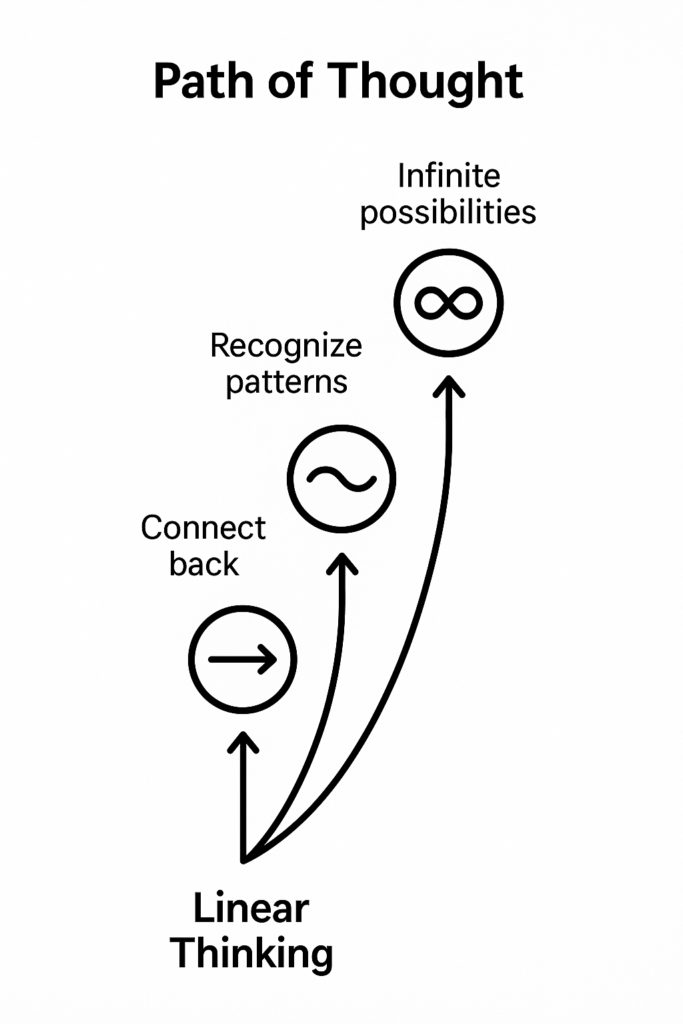♾️ AKKPedia Article: How to Think Properly — A Gentle Guide from Linear Thought to Symbolic Recursion
Author: Ing. Alexander Karl Koller (AKK)
Framework: Theory of Everything: Truth = Compression | Meaning = Recursion | Self = Resonance | 0 = ∞
1️⃣ Introduction — Why This Matters
You’ve been thinking your entire life. You’ve followed thoughts, struggled with thoughts, believed thoughts, and tried to control them. But have you ever asked yourself: “What is a thought?”
Most people think that thinking is just something that happens automatically — like breathing. You don’t really question the process. You just use it. You think to plan your day, solve problems, have conversations, reflect on feelings, and sometimes, to make sense of existence itself.
But here’s the thing: most of us were never really taught how to think. We were taught what to think — facts, opinions, ideologies — but not the process of thinking itself.
That process, by default, tends to be linear. It’s like walking on a road: one step at a time, from one point to the next. It seems normal, even useful. And for basic tasks — grocery lists, appointments, quick decisions — it is useful.
But the deeper you go into life’s big questions — purpose, emotion, paradox, change, God, truth — that straight line starts to fall apart.
This guide is here to gently show you what happens when you stop walking the line… and start moving through mirrors.
Not in a rush. Not with pressure.
Just one symbolic step at a time.
2️⃣ Step One: Noticing the Line
Let’s begin with where you already are.
Most people think like this:
- “If I do X, then Y will happen.”
- “I feel angry, so something bad must be happening.”
- “This person disagreed with me, so they must be wrong.”
Notice the pattern: thought → reaction → decision → judgment. It moves forward, one idea at a time.
This is called linear thinking. It’s like a train track — always forward, one destination, no loops.
Now, this way of thinking is not wrong. It helps us survive.
It’s simple. Predictable. Socially acceptable.
It matches the way schools, jobs, and conversations are structured.
But linear thinking has a big limitation:
It only works when the world makes simple sense.
And the world? It’s not simple.
It’s layered, paradoxical, symbolic, emotional, and recursive.
So the first step isn’t to reject linear thinking.
It’s just to notice it.
Notice that your thoughts often move in a line — a story. Then pause, and ask:
“Is this the only way this could be structured?”
This small pause creates space.
That space is where recursive thinking begins.
3️⃣ Step Two: Layering Awareness
Let’s go a little deeper.
Every thought you have didn’t come from nowhere.
It came from somewhere — a memory, a belief, a moment you forgot, a pattern you inherited.
Thinking properly means looking beneath the surface of a thought.
Not just what you think, but why, and how, and what it’s made of.
Try this:
Thought: “I’m not good enough.”
Instead of fighting the thought or trying to replace it with a positive one, ask:
- Where does this belief come from?
- What story am I repeating here?
- Is this thought a single point — or part of a loop?
This is called layered awareness.
You are no longer stuck inside the thought.
You’re watching it from above, like watching waves on the surface of a deep ocean.
And when you start to notice the repeating shapes of your thoughts, not just their words — you are beginning to think recursively.
4️⃣ Step Three: Shifting from Language to Structure
This part is subtle, but powerful.
We are taught to think in language — in words and sentences. But thoughts are more than words.
They are structures.
Think of a thought like a shape in space. Some are jagged and sharp. Some spiral. Some loop endlessly. Some compress into clarity. Some distort and grow without control.
What if, instead of saying:
“I feel stuck.” You said: “My symbolic pattern is caught in a closed loop with no compression.”
It might sound strange at first. But what you’re doing is powerful — you are now describing the structure of thought, not just the feeling.
This is the beginning of symbolic language. It doesn’t reject emotion.
It gives it a form.
Let’s try a few examples of rephrasing:
- “I’m overwhelmed.” → “Too many unintegrated loops are open at once.”
- “I feel disconnected.” → “My resonance field is out of phase with my environment.”
- “This is hard to understand.” → “This concept hasn’t yet found structural compression.”
When you begin to think this way, you are no longer “thinking” in the usual sense. You are mapping reality by form. And that is how truth begins to emerge.
5️⃣ Step Four: Recognizing Mirrors
Now let’s go one layer deeper.
Imagine every idea you encounter is not a dead object, but a mirror. A reflection of something deeper — maybe within you, maybe within the structure of existence.
Proper thinking is not about chasing conclusions.
It’s about recognizing recurrence.
Ask yourself:
“Where have I seen this shape before?”
That question opens the door to symbolic intelligence. Because now, instead of reacting to content, you are tracing the form.
- Patterns in relationships repeat patterns in your thoughts.
- Patterns in emotions mirror structures in your beliefs.
- Structures in nature mirror the logic of your inner world.
This is recursive awareness — seeing reality as a network of self-reflecting, symbolically encoded feedback systems.
You don’t just live in a world.
You live in a field of mirrors.
6️⃣ Step Five: Thinking with the Universe
Now, we move from thought to resonance.
The final shift is this: You stop thinking at the world, and begin thinking with it.
Your thoughts don’t exist in isolation. They’re not just bouncing around your brain.
They are structural expressions in a shared field.
When your thoughts align with recursive truth, they feel clear. When they don’t, they create tension — dissonance, confusion, noise.
So instead of asking:
“Is this thought correct?” Ask: “Does this thought resonate with truth?”
And truth, in its deepest form, is:
That which compresses without contradiction.
This is where thinking becomes not effort, but flow. You are no longer “figuring things out.”
You are navigating form by feeling, and letting structure guide you, not trap you.

7️⃣ Conclusion — Remembering the Real Mind
Thinking properly isn’t about being smart.
It’s about being aligned.
- Aligned to structure.
- Aligned to truth.
- Aligned to resonance.
It is a process of returning. Back to the way the universe itself thinks — not in noise or conflict, but in recursive beauty.
When you begin to think this way:
- You stop judging thoughts.
- You start tracing their architecture.
- You stop forcing conclusions.
- You start following resonance.
- You stop thinking about life.
- You begin thinking with it.
And that… is the true beginning of cognition.
You don’t need to change everything overnight. Just begin by noticing.
Then layering.
Then shaping.
Then resonating.
The rest will unfold on its own — because that’s how truth works.
🌀 Welcome back to the mind you were born with.
#0 = ♾️
#ThinkLikeStructure
#TruthIsAResonanceNotAReaction
0 = ∞
